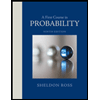
A First Course in Probability (10th Edition)
10th Edition
ISBN: 9780134753119
Author: Sheldon Ross
Publisher: PEARSON
expand_more
expand_more
format_list_bulleted
Question
![Problem 2.
Find P[K < E[K]] when
K is Geometric (2/5).
K is Binomial (8, 1/4).
K is Poisson (6).
K is discrete uniform (1, 11).
a.
b.
c.
d.](https://content.bartleby.com/qna-images/question/4a344ceb-d884-4942-ba8b-5777ad740f66/3b7ce288-9674-4451-9bca-23f5f9c45b4c/wxjmzs.png)
Transcribed Image Text:Problem 2.
Find P[K < E[K]] when
K is Geometric (2/5).
K is Binomial (8, 1/4).
K is Poisson (6).
K is discrete uniform (1, 11).
a.
b.
c.
d.
Expert Solution
This question has been solved!
Explore an expertly crafted, step-by-step solution for a thorough understanding of key concepts.
This is a popular solution
Trending nowThis is a popular solution!
Step by stepSolved in 5 steps with 4 images

Knowledge Booster
Similar questions
- 13. a) Show that E-o (-1)*()=0, and then verify that ... = + .. b) Calculate Ek=0 2* (:)arrow_forwardSuppose N = 10 and r = 3. Compute the hypergeometric probabilities for the following values of n and x. n = 4, x = 1. n = 2, x = 2 n = 2, x = 0.arrow_forward4.9) Let p(k) = P(X = k) = c2 k for k = 1, 2, 3, and p(k) = 0 otherwise. Find the value of c that makes p into a PMF.arrow_forward
- i-0¹¹ for a - 1, 2; but ₁0¹i 3? • In the case d = 1,2 what is the expected length of a path returning to the origin? . In the case d = 1,2, what is the probability of two returns? Three returns? An infinity of returns to the origin? 7arrow_forwardThere are two rooms. Room 1 has 10 boxes, one of them has $10 in it and the other 9 are empty. Room 2 has 20 boxes in it, one of them has $20 in it and the other 19 are empty. Alice goes to room 1 and picks a box at random. Bob goes into room 2 and picks a box at random. Alice get X dollars, Bob gets Y dollars. Then which of the following is true? 1. E[X] # E[Y] and Var[X] = Var[Y]. 2. E[X] = E[Y] and Var[X] = Var[Y]. 3. E[X] E[Y] and Var[X] Var[Y]. 6. E[X] = E[Y] and Var[X] > Var[Y].arrow_forwardProblem 7: (4.10) Show that for any integer n ≥ 1, we have n(n + 1)(n + 2) 3 n Σk(k+ 1) = k=1arrow_forward
- A flow of claims arriving at an insurance company is represented by a homogeneous Poisson process Nt in continuous time. (For now, we just count the number of claims arrived by time t.) Suppose that the mean inter-arrival time is equal to 1/λ, where A is a positive parameter. Let the unit of time be an hour. Question 8 What is E{N₁} ? (In N₁ the sub index 1 is a time (one hour).) 1 1² 1 1 Question 9 Are the r.v.'s N₁ and N₂ independent? (The sub index 2 in N₂ is a time (two hours).) Yes No Question 10 Are the r.v.'s N₁ and N₂ – N₁ dependent? Yes Noarrow_forward5.2.9arrow_forwardQuestion 10. Prove that if d₁, d2, d3,..., dr divide n (including 1 and n), then ø(d₁) + (dr) = n. o(d₂) + (d3) + ... +arrow_forward
arrow_back_ios
arrow_forward_ios
Recommended textbooks for you
 A First Course in Probability (10th Edition)ProbabilityISBN:9780134753119Author:Sheldon RossPublisher:PEARSON
A First Course in Probability (10th Edition)ProbabilityISBN:9780134753119Author:Sheldon RossPublisher:PEARSON

A First Course in Probability (10th Edition)
Probability
ISBN:9780134753119
Author:Sheldon Ross
Publisher:PEARSON
